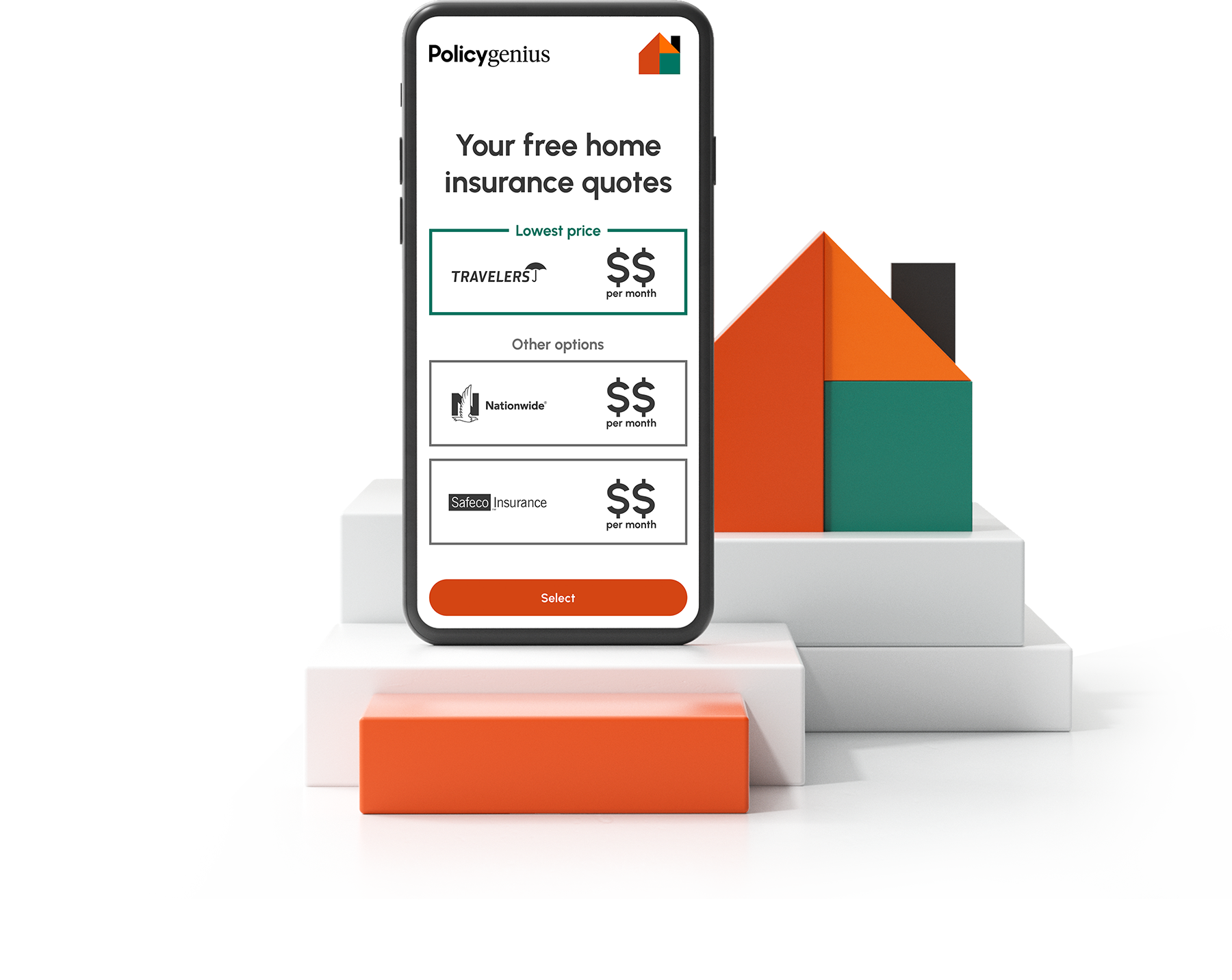Homeowners insurance coverage explained
Homeowners insurance provides coverage for your home and personal belongings in case of unexpected damage or loss. It also comes with liability protection that shields your assets from expensive legal judgements if you’re found negligent for an injury or property damage. Without home insurance, you’d need to cover these costs out of your own pocket.
A basic homeowners insurance policy comes with six main coverages: dwelling, other structures, personal property, loss of use, liability, and medical payments. Here’s how each one works and how much of each you need, according to experts at the Insurance Information Institute: [1]
Coverage type | What it does | How much you need |
|---|---|---|
Pays to repair or rebuild your house and structures attached to it | Enough to completely rebuild your home from the ground up | |
Pays to repair or rebuild your shed, guest house, fence, or other structures on your property not attached to your home | 10% of your dwelling coverage limit | |
Pays to replace furniture, electronics, kitchen appliances, and other stuff you own | 50% to 70% of your dwelling coverage limit | |
Pays for hotel stays, rentals, restaurant bills, and other temporary expenses while your home is being rebuilt | 20% of your dwelling coverage limit | |
Pays for guests' medical bills and legal expenses if you’re found legally responsible | $100,000 to $500,000 | |
Pays for guests' medical bills from minor injuries — regardless of who’s at fault | $1,000 to $5,000 |
Dwelling coverage
Also known as Coverage A, dwelling coverage helps cover the cost of damage to your home's structure, including the walls, roof, windows, and foundation. This coverage also covers your home’s plumbing, electrical, HVAC systems, and built-in appliances like furnaces and water heaters. If your home has an attached garage, deck, or porch, that’s generally covered as well.
What type of damage is covered?
Fire, smoke, wind, hail, weight of snow or ice, lightning, and many of the other most common causes of structural damage to your home are covered by the dwelling section of your policy.
However, the best way to find out if damage to your house is covered or not is by understanding what isn’t covered. That’s because in a standard HO-3 insurance policy, your home (dwelling) and standalone buildings on your property (other structures) are covered on an open perils basis. This means all causes of damage are covered except for the following policy exclusions:
Earthquakes, landslides, sinkholes
Flooding
Government action
Intentional loss
Neglect or wear and tear
Nuclear hazard
Water damage from sewer backups
Pest infestations
Power surges caused by the utility company
War
If your house is damaged and you file a claim, the burden of proof is on your insurer to prove that the loss is not covered. Because the onus is on your insurance company, open perils is considered the most comprehensive type of home insurance protection.
Learn more >> How does dwelling coverage work & how much do you need?
Other structures coverage
The other structures section of your homeowners insurance policy covers structures on your property not attached to your home, including a standalone garage, guest house, fences, gardening sheds, and mailboxes.
What type of damage is covered?
Other structures are also covered on an open perils basis, meaning fire, wind, theft, vandalism, and anything else that is not a specific policy exclusion is covered.
Learn more >> How does other structures coverage work?
Personal property coverage
The personal property section of your policy covers damage or theft of your belongings, such as furniture, electronics, clothing, washing machines, sports equipment, and basically anything that you can move into or out of your home. This coverage applies to belongings inside your house and anywhere else in the world.
What type of damage is covered?
Unlike the previous two sections of your policy, personal property is covered by named perils. This means the cause of damage or loss has to specifically listed in your policy in order for your insurance to pay out. In most cases, personal property insurance provides coverage for the following 16 perils:
With named perils personal property coverage, the burden of proof is on you (not your insurer) to prove the loss was caused by one or more of the named perils. While the onus is on you this time to prove the loss is covered, you’re still protected against up to 16 perils, making this one of the broadest forms of coverage.
Learn more >> What is personal property coverage?
Loss of use coverage
Also known as additional living expenses (ALE), loss of use coverage pays for your temporary living expenses if your house is damaged by a covered disaster — like a fire, hurricane, or tornado — and you need to live somewhere else during repairs. If you’re displaced from your home due to flooding, earthquake damage, or any other home insurance policy exclusion, your insurance won’t cover your additional living expenses.
What type of expenses are covered?
Most standard policies will cover any reasonable additional living expenses that exceed your normal monthly budget. Those expenses include, but are not limited to the following:
Hotel stays
Temporary rentals
Restaurant meals
Groceries
Relocation (fuel, rental cars, public transit)
Dry cleaning
Pet boarding
Storage units
Learn more >> What is loss of use coverage in homeowners insurance?
Liability coverage
Liability coverage protects your finances and assets in case you’re found negligent for somebody else’s injury or property damage and sued. Common liability incidents include trampoline or pool-related injuries, slip and fall accidents, and dog bites.
What type of expenses are covered?
Here are a few common liability coverage claims that may be covered by homeowners insurance. Keep in mind that for any of these to be covered, it needs to be proven that you or a household relative’s negligence caused the incident to occur:
Medical bills if a guest is injured on your property
Damage to someone else’s property
Legal expenses, including lawyer fees, court fees, and judgements
Learn more >> What is personal liability coverage?
Medical payments coverage
The medical payments portion of your policy covers minor injuries to guests if they’re injured on your property, whether you’re negligent for the injury or not. This is the least common type of claim — it only accounted for 0.3% of homeowners insurance losses in 2020, according to the Insurance Information Institute. [2]
What type of expenses are covered?
Minor physical injuries that occur to a guest on your property — regardless of who is at fault. Covered expenses include:
Health insurance deductibles and copays
Doctor or hospital visits
Medical, dental, or surgical procedures
Keep in mind this does not cover injuries to family or friends who are permanent residents of the home.
Learn more >> What is medical payments coverage?
Overview of what is & isn’t covered by home insurance
Your homeowners insurance policy will list out which perils are covered and not covered. But there’s some gray area to consider here as well, as some policy exclusions (like water damage) may actually be covered under a certain set of circumstances.
Here’s an example of perils that are usually covered, sometimes covered, and rarely covered under a standard home insurance policy.
Incident | Is it covered? | Explanation |
|---|---|---|
Fire | Usually | Most homeowners insurance policies cover fire damage, though coverage may be limited in areas prone to wildfires. |
Roof leaks | Sometimes | Whether or not home insurance will cover a roof leak depends on the source of the damage. Sudden damage from wind or hail would likely be covered, but a gradual leak due to normal wear and tear would likely not be covered. |
Theft | Usually | Most home insurance policies cover theft of personal belongings in most scenarios, including theft from your home, car, or hotel room. |
Plumbing | Sometimes | Standard home insurance covers plumbing damage if it's sudden and unexpected, but gradual water damage or pipe leaks generally won't be covered. |
Water damage | Sometimes | While most policies won't cover damage caused by natural flooding (like storm surge or flash floods), home insurance may cover water damage that's sudden and accidental, like a burst pipe. |
Mold | Sometimes | If the underlying cause is sudden and unexpected or hidden water damage, then home insurance may cover mold remediation and removal. Otherwise, it generally is not covered. |
Termite infestation | Rarely | Home insurance generally won't cover damage caused by termites nor their removal except for a rare set of circumstances. |
Dog bites | Sometimes | Your policy's liability protection will likely cover medical and legal expenses from a dog bite unless your dog's specific breed is excluded from coverage. |
Foundation issues | Sometimes | Home insurance can cover everything from foundation issues to broken pipes under slab as long as the cause of the damage is covered. But the natural settling of your foundation or normal wear and tear is not covered. |
Lost or misplaced items | Rarely | Unless you upgrade your personal property coverage to open perils or broaden coverage via a schedule personal property endorsement, lost or misplaced items are generally not covered. |
HVAC system | Sometimes | If your HVAC is damaged by a covered peril like lightning, fire, or sudden water damage, you may be covered. But damage due to maintenance issues or normal wear and tear are not covered. |
Understanding coverage for earthquakes and floods
For an additional cost, some home insurance companies will let you add flood or earthquake coverage to your homeowners insurance as an optional add-on. If your insurer doesn’t offer this, you’ll have to purchase separate flood insurance or earthquake insurance policies to protect your home and belongings from those disasters.
Increase your home insurance coverage with endorsements
Most insurance companies offer a variety of optional coverages that can add an extra layer of protection for the structure of your home, increase coverage limits on expensive items like jewelry, and expand coverage to protect against losses that aren’t normally covered by a standard policy.
But few homeowners actually take advantage of these policy add-ons. According to our Policygenius Home Insurance & Inflation Shopping Survey, 33% of homeowners don't know if they have any of these extra coverages. And just 17% have ordinance or law or inflation guard protection — two valuable endorsements that can protect you from rising rebuild costs after a natural disaster.
To ensure your home is fully protected, here's a look at popular endorsements you should consider adding to your home insurance policy:
Ordinance or law: This covers the increased cost of construction if your house is damaged and needs to be rebuilt or repaired according to local building codes.
Inflation guard: This automatically adjusts your coverage each year to compensate for increases in construction and labor costs in your area due to inflation.
Scheduled personal property: This increases coverage limits on high-value items with lower sublimits in a standard policy, including jewelry, fine art, and firearms.
Water backup: This covers water damage caused by backed up drains, septic tanks, sewer pipes, and sump pumps.
Equipment breakdown: This covers the cost of appliance replacement or repairs in the event the appliance breaks down due to mechanical or electrical failure.
Service line: This covers service line breaks on your property that need to be excavated or repaired. This coverage applies to cable lines, drain pipes, Internet lines, power lines, sewer lines, and more.
Learn more >> 13 home insurance policy endorsements
How does homeowners insurance work?
To keep your homeowners insurance coverage active and ensure your house stays protected, you pay a premium to your insurance company. In the unfortunate event that you need to use this coverage, you’ll first have to report the claim to your insurer and provide evidence of the damage or loss, after which point your insurer will review the claim and reimburse you for it.
Your claim payment amount will depend on your coverage limits, how much evidence you were able to provide for the loss, your out-of-pocket deductible amount, and the loss settlement provision (aka coverage level) that the insurer uses to calculate how much it pays out.
Here’s a look at how each coverage level works, which part of your policy it applies to, and how it factors in to the insurance claim process.
Coverage level | How does it work? | Which coverage is it for? |
|---|---|---|
Subtracts depreciation from your claim payout | Personal property* | |
Covers the value of damaged or stolen property without subtracting depreciation from your payout | Dwelling, other structures, and personal property | |
Increases your dwelling coverage limit a specified percentage (usually 25% or 50%) if your home is damaged and your dwelling limit isn't high enough | Dwelling and other structures | |
Reimburses you for a full rebuild — regardless of how much it costs | Dwelling and other structures |
* Most standard home insurance policies come with actual cash value personal property coverage and replacement cost dwelling coverage. But depending on your insurer and what they offer, you may be able to upgrade to the next level of coverage for an additional fee.
Homeowners insurance deductibles
Your home insurance deductible is the amount you're responsible for paying out of pocket before your insurance kicks in to cover the rest of your claim. There are generally two types of deductibles:
Dollar amount deductibles: This is a flat dollar amount that you’ll pay on most types of claims. While the standard dollar amount deductible is typically $500 or $1,000, some insurers also offer high deductible policy options.
Percentage deductibles: This deductible represents a percentage (like 1% or 3%) of your home’s insured value (aka your dwelling coverage limit). These deductibles typically apply to wind damage claims, and are generally offered in states where tornado and hurricane disasters are common.
Before sending you your claim reimbursement, your insurer will subtract the deductible amount from the loss or damage amount. For example, if your deductible is $1,000 and your house suffers $20,000 in damages, your insurer would subtract $1,000 from that amount before paying you the remaining $19,000 for repairs.
While choosing a high deductible can lower your homeowners insurance premium, you'll have to pay more out of pocket when you file a claim. If you have a low deductible, you’ll pay higher premiums but lower out of pocket costs when you make a claim.
How to find out how much coverage you need
In recent years, high inflation and increased construction costs have have left many homeowners without enough coverage to fully rebuild their homes and replace their belongings after a disaster.
Follow these steps to estimate how much coverage you need for each of the six different sections of your home insurance policy.
Most home insurance companies will help you estimate how much coverage you need for each by answering a few questions about yourself and your home. Our team of licensed insurance experts at Policygenius can also help you review your coverage limits to ensure everything you care about is fully protected.
Learn more >> How much home insurance do I need?




